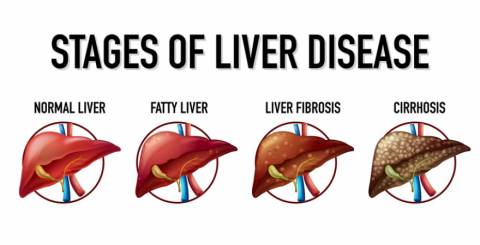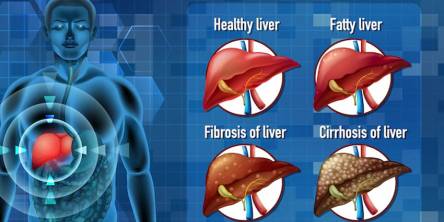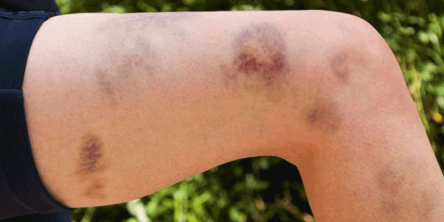Yakrit Plihantak Churna - Ayurvedic Solution for Liver Support

ABSTRACT
Fatty Liver Disease (Steatosis) is a common condition which denotes the excessive accumulation of fat in the liver. The liver is located in the upper right-hand portion of the abdominal cavity on the stomach, kidney and intestines. The liver is the major metabolic organ which is found in vertebrate animals. It is a dark red organ with 2 lobes (made of 8 segments and 1000 lobules) and is approximately 1.5 kg. The liver gets the blood supply from 2 distinct sources which include- Oxygenated blood from the hepatic artery and the nutrient-rich flows from the hepatic portal vein. The liver regulates the chemical level in the blood which excretes the product known as Bile. Further, we will discuss the herbal supplement name YakritPlihantak Churna which is formulated by planet Ayurveda and is helpful in the treatment of fatty liver and various other liver problems.
INTRODUCTION
Fatty Liver is the extra deposits of fat in the liver, known as Hepatic Steatosis which contains a small amount of fat which becomes when the fat reaches 5% of liver Weight. It affects about every 10 people which may develop some complications. Fatty changes begin with the development of minute membrane-bounded inclusions which are closely applied to the endoplasmic reticulum. The liver will resemble an adult adipose tissue cell. It becomes contagious; it may rupture and produces fatty cysts.
There are mainly two types of fatty liver disease
- Nonalcoholic fatty liver disease (NAFLD)
- Alcoholic Fatty Liver disease which is known as Alcoholic steatohepatitis
1. NON-ALCOHOLIC LIVER DISEASE
It causes no inflammation and no damage to the liver. This inflammation and liver damage causes fibrosis and scarring of the liver. Nash leads to Cirrhosis and Liver Cancer.
2. ALCOHOLIC LIVER DISEASE
It is due to heavy intake of alcohol which breaks down the liver cells and generates various harmful substances in the body. It damages the liver cells and promotes inflammation which damages the liver.
PATHOLOGY
- Fatty changes represent the accumulation of fats which begins the development of fat around the nucleus.
- During this, liver cells are filled with multiple droplets of fats.
- Then in later stages, these multiple fat droplets increase in size and push towards the periphery of the cell.
In the case of Fatty liver, it is not a serious problem but it can worsen over time. It progresses through three stages-
- The liver becomes inflamed which damages the liver tissues which is known as Steatohepatitis
- This scar tissue is formed when the liver cells get damaged, this is known as Fibrosis
- This Scar formation replaces the healthy tissues which is known as Cirrhosis of the liver.
CAUSES OF FATTY LIVER
- Overweight
- Type 2 diabetes
- High Cholesterol
- Taking medications such as Diltiazem, Tamoxifen
- Alcohol use disorder
- Bacterial overgrowth
- Jejunal diverticulosis
- Inflammatory disorders
SYMPTOMS OF FATTY LIVER DISEASE
- Abdominal pain
- Nausea
- Weight Loss
- Oedema
- Extreme Tiredness
- Mental Confusion
- Enlarged Spleen
- Yellowing of the skin and eyes
- Long Lasting Itching
DIAGNOSIS
- Ultrasound
- CT Scan (Computed tomography)
- Liver Biopsy
- FibroScan
COMPLICATIONS
- The main complication of fatty liver leads to NASH to Cirrhosis, this cirrhosis leads to permanent scarring and hardening of the liver.
- Digestion related issues
TREATMENT
- Avoiding alcohol
- Losing weight
- Taking the medications which manage diabetes, Cholesterol and Triglycerides
- Taking Vitamin E
AYURVEDIC ASPECT
In Ayurveda, the Liver is described as Yakrit and Pleha denotes Spleen. They are interrelated organs which are serving the same physiology and the formation of the blood. The roots are Raktavaha Srotas (minute channels which are related to the formation and carrying of the blood) which lie in Yakrit and Pliha.
Yakrit is maintained by Pitta Doshas, which is a subtype of Ranjaka Pitta. Ranjaka means Colour, this gets diminished along with Pachaka Pitta, the whole Pitta zone reduces its fragments and the metabolism becomes sluggish, the immunity of cells leads to various health issues. And further, the Rasa Dhatu (the first tissue) enters the Yakrit and Pleeha, this Ranjaka pitta provides color to the Rasa Dhatu and gets transformed into Rakta Dhatu and the blood tissues. In this condition, Agni also plays a very important role as Mandagni and Mal Sanchay are the two leading causes of Udar rogas.
TRIDOSHAS INVOLVEMENT IN FATTY LIVER DISEASE
There are three doshas that rule and control life (Vata, Pitta and Kapha) which are moving through the whole body and blood is pushed by Vata doshas. Vata and Kapha are the buffers of the body, it reduces the heat and empowers the heating zone. When the heat of Yakrit gets reduced the coldness of Kapha and Vata passes through Yakrit and the liver tends to be sluggish. Every cell of the body is made up of tridoshas and if Pitta is decreased in liver cells it leads to an increase in Kapha doshas. When the liver fails to metabolize the predominant Kapha along with medas (free fat) it tends to accumulate in the liver which causes deteriorating liver physiology.
YAKRIT PLIHANTAK CHURNA - HERBAL REMEDY FOR FATTY LIVER BY PLANET AYURVEDA
Planet Ayurveda is a recognized organization which provides various herbal supplements worldwide which are formulated under the supervision of Experts Ayurvedic doctors. Additionally, it offers Video Call Consultation with Team experts and medical professionals Worldwide. The Supplements which are manufactured are free from any preservatives, Additives and chemicals. YakritPlihantak Churna is a herbal powder which is made up of pure herbs that are useful in regenerating the cells of the liver which we will discuss further-
YAKRIT PLIHANTAK CHURNA
It is an amazing Ayurvedic preparation for Yakrit and Pleeha Rogas which contains various herbs such as Kalmegh, Bhringraj, Bhumi Amla and more. It is helpful in many liver conditions such as fatty liver, Jaundice, cirrhosis, Alcoholic liver disease and various diseases of the spleen.
VARIOUS INGREDIENTS OF YAKRIT PLIHANTAK CHURNA
1. BHUMI AMLA
Bhumi Amla (Phyllanthus Niruri) is a tropical plant which grows up to a height of 70 cm. Found on small land and found in the rainy season. Found in a Temperate climate over Coastal India. Bhumi Amla is tiny, smooth and contains various seeds. It is helpful in reducing the Kapha and Pitta Doshas.
Benefits of Bhumi Amla
- Effective in anaemic patients
- Improves the taste and anorexia condition
- Treats Splenomegaly, Hepatomegaly.
- Has Tikta (bitter) and Kashaya (astringent) taste.
- Helpful in healing injuries
2. BHRINGRAJ
Bhringraj (Eclipta alba) is a creeping herb which grows at a height of 3 metres. Commonly known as False Daisy and is considered a Rasayan herb for its rejuvenation property. It is a native of India and Southwest America and is commonly found in China and Brazil. Grows throughout India in paddy-growing fields.
Benefits of Bhringraj
- Has amazing benefits in the form of oil, which helps premature greying and split ends.
- Stimulate the digestive fire
- Good for healthy functioning of the Liver, thus improving liver metabolism.
- Has antimicrobial properties and cures infections
3. KALMEGH
Kalmegh (Andrographis paniculata) is a shrub which is found throughout India, this plant is found throughout India in West Bengal. Found in Gardens, Rural Areas and in Easte places. Commonly known as Green Chiretta and known as a “bitter tonic”. Mainly herbs like leaves and roots are useful in different traditional applications.
Benefits of Kalmegh
- Helpful in the detoxification of the liver
- Prevents Blood clotting formation
- Has anti-inflammatory properties which inhibit inflammation
- Indicated in skin diseases and in loss of appetite
4. SHARPUNKHA
Sharpunkha (Tephrosia purpurea) is a perennial effect which grows up to 50 cm tall in height. The stem of this plant is woody and thick and the outer surface is green and glabrous. The seeds of this herb are ellipsoid and dark brown in colour. Found commonly in wasteland and is cultivated in green manure crops. Balances Vata and Kapha doshas.
Benefits of Sharpunkha
- Useful in the treatment of liver cirrhosis, in detoxification of the liver and regeneration of new liver cells.
- Helpful in the treatment of various skin disorders, which heals the skin
- Maintains healthy blood sugar levels.
- Has various Anti-inflammatory properties which reduce body aches.
- Resolves Digestive disorders and provides relief in Indigestion and in intestine pain.
5. Kaasni
Kaasni (Cichorium intybus) Chicory is grown in Egypt and purifies the blood. It is found in temperate parts of the world and is often cultivated in various Countries. It is a perennial herb, which is erect and woody around 1 metre in height. Found in the high-temperature zone in both Vegetative and reproductive growth stages. The root has a bitter and mucilaginous taste. Mostly cultivated in Bihar, Maharashtra, Tamil Nadu and in the States of Punjab and in North West India.
Benefits of Kasni
- Stimulates and protects the liver from congestion and cirrhosis.
- Stimulates production of urine and bladder
- Helpful in the detoxification of blood
- Has Arteriosclerosis and Digestive properties
INDICATIONS
- Liver Failure
- Hepatitis
- Enlarged Spleen
- Alcoholic Liver Disease
- Jaundice
BENEFITS
- Natural Alkalizer
- Prevents Liver Ailments
- Aids Fats metabolism
- Rejuvenates damaged liver cells
- Eliminates toxins from the liver
- Rectifies Liver Failure
DOSAGE - 1 tsp twice daily with plain water after meals.
CONCLUSION
Fatty Liver Disease (Steatosis) is a common condition that denotes the excessive accumulation of fat in the liver. The liver is located in the upper right-hand portion of the abdominal cavity on the stomach, kidney, and intestines. The liver will resemble an adult adipose tissue cell. It becomes contagious; it may rupture and produce fatty cysts. In Ayurveda, the Liver is described as Yakrit and Pleha denotes Spleen. They are interrelated organs which are serving the same physiology and the formation of the blood. When the liver fails to metabolise the predominant Kapha along with medas (free fat) it tends to accumulate in the liver which causes deteriorating liver physiology. Further, we discussed Yakrit Plihantak Churna from planet Ayurveda which is helpful in liver conditions and without causing any side effects.
Similar Articles
The liver is a Vital organ which is responsible for a number of essential functions that include detoxification of harmful substance, metabolising nutrients, production of bile for digestion, regulates blood sugar levels by storing and releasing glucose, synthesis of protein, break down of fats through Beta- oxidation.
In ancient times when there was no professional method of health examination, people usually figured out health problems because of signs on one’s appearance. The change of skin color might be one of the most common signs that show something unusual inside the body.
When looking for help for substance abuse, finding and selecting the right drug rehab facility is a crucial step toward a patient's recovery. While there are plentiful options available, it can be overwhelming for people to choose the best one suited to their individual needs.
According to the World Health organization (WHO), Mental disorders are on the rise in this era, every one in eight individuals is suffering from a mental disorder. There are a variety of mental health disorders
Nowadays dental problems are so common in day-to-day life we know someone who is suffering from dental problems or sometimes it happens to us only
Burger, Pizza, Cold-drink, Sweets, Chocolate, Fries, Samosas, I know your mouth is watering after reading this, right?. But do you know how it is destroying our digestive system and especially our liver
People are pursuing their objectives and dreams with such savagery that they neglect to do the basic things right. The developing rivalry in working environments and the requirement for steady proficient improvement are what shapes our lives
Nowadays many people are suffering from thrombocytopenia or ITP. This is basically a condition of low platelet count. After listing the name of this disease, few questions arise in the mind of everyone. What are platelets, what is their significance in the body, what are the possible consequences of reduced platelets?
Fibromyalgia is a chronic pain disorder that is very common as well as complex affection for the patient physically, mentally, and socially as well. It is a type of neurosensory disorder that shows symptoms like stiffness in the joint, widespread muscle pain, and fatigue









